|
==============================================================================
TOPIC: Gettysburg National Military Park
http://groups.google.com/group/entstrees/browse_thread/thread/ae9e197fcd2f7d7c?hl=en
==============================================================================
== 1 of 1 ==
Date: Wed, Oct 15 2008 5:38 pm
From: "Dale Luthringer"
ENTS,
From 4/29-5/2/08 I had the privilege of spending 4 whole days in
Gettysburg National Military Park in conjunction with our yearly
mandatory training that was held in the area. Needless to say, once
the
training sessions were done in the day, every evening was spent
combing
the fields and woods of this epic national battlefield.
http://www.nps.gov/gett
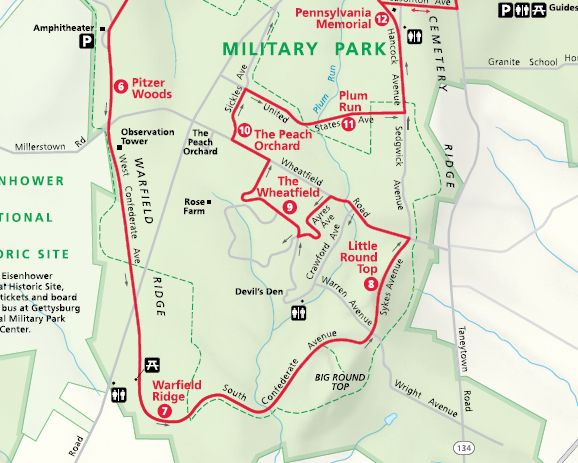
"The Battle of Gettysburg was a turning point in the Civil War,
the
Union victory in the summer of 1863 that ended General Robert E.
Lee's
second and most ambitious invasion of the North. Often referred to
as
the "High Water Mark of the Confederacy", it was the war's
bloodiest
battle with 51,000 casualties. It also provided President Abraham
Lincoln with the setting for his most famous address."
http://www.nps.gov/gett/siteindex.htm
http://www.nps.gov/gett/photosmultimedia/photogallery.htm
http://www.nps.gov/gett/historyculture/gettysburg-podcast-tours.htm
The evening of 4/29 was mostly used to get acquainted with the
general
topography of the land. I started by first driving from the
beginning
of the Picketts Charge area and ending at Plum Run and Big Round Top
along South Confederate Avenue. Just before the road bends to the
right
towards Plum Run, I noticed some "odd" pines growing off
the south side
of the road.
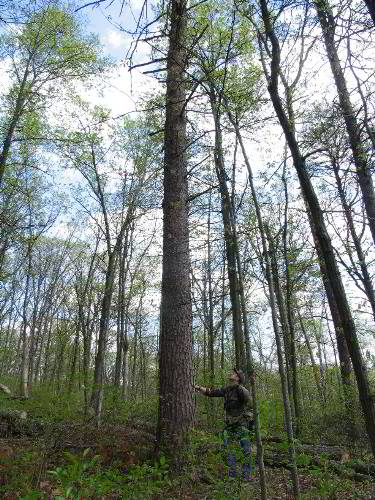
Virginia Pine 5.8 CBH x 94.5 height.
Turns out they were some decent Virginia pine. I never
get to see these up at Cook Forest, so they were quite the pleasure
to
measure. One not only turned out to be what I believe is the tallest
ENTS documented so far in the NE, but also a new Pennsylvania state
champ at 5.8ft CBH x 94.5ft high x 31.6ft avg crown for 172 AF
Points.
http://www.nps.gov/ner/pgallerycontent/p/l/20071128100312.jpg
http://www.nps.gov/archive/gett/getttour/tstops/tstd3-19.htm
http://www.nps.gov/archive/gett/getttour/tstops/tstd3-20.htm
Granted, there are very few in the database up here, but at least
we've
got an idea of what they can do when given ~100 years to grow. An
adjacent and recently cut Virginia pine yielded ~94 rings at 0.6ft
up at
1.6ft in diameter.
It was also nice to measure a few redbud in the area which were in
peak
bloom. This is another species that I never get to see growing
naturally in NW PA, but down in SE PA they are a common component
along
forest edges.
The park is actively managing certain areas of the battlefield to
return
the land to what they deem was a more period appropriate younger
forest.
So, the rings that were documented in this post, were taken directly
from these recently downed trees. It will be apparent that some of
these downed trees actually pre-date the battle of Gettysburg. They
were much smaller then, but many had witnessed the battle that raged
around and through them. So, trees that are over 145 rings,
obviously
pre-date the battle in 1863.
A nearby N. red oak, closer to Plum Run was ~123 rings 0.7ft up at
3.3ft
diameter. A recently downed white oak in the area of Seminary Ridge
and
Pitzer Woods came in at ~211 rings.
Tree species noted in the vicinity of Plum Run were as follows:
Virginia pine, redbud, spicebush, black oak, N. red oak, chestnut
oak,
white oak, bitternut hickory, shagbark hickory, pignut hickory, E.
white
pine, E. red cedar, tuliptree.
Continuing further down South Confederate Avenue after passing over
Plum
Run, a decent stand of tulips emerged near the base of Big Round Top
that topped out in the low 130ft class.
I then turned down Warren Avenue with Little Round Top on my right
with
the Devil's Den laying out to the front. I stood up on the rocks of
the
Devils Den looking down into the Slaughter Pen and attempted the
impossible, trying to imagine what it must have been like for the
1000's
of men who died in this area attempting to take Little Round Top. I
felt a definite sense of some sort of strong power at this site.
This
was a very special area. I had this same feeling years ago when I
first
looked out from Little Round Top down into the Devil's Den on a
prior
trip back in the mid 1990's, but this was the first time I set foot
in
the Devil's Den. What a remarkable place.
http://www.nps.gov/gett/naturescience/geologicformations.htm
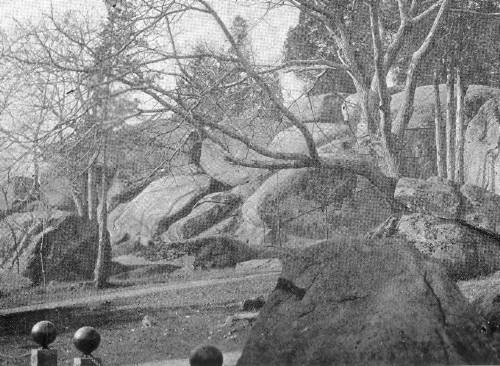
http://www.nps.gov/ner/pgallerycontent/p/l/20071128095538.jpg
I then headed back up towards Little Round Top for a panoramic view
of
the area at dusk. I walked back down the hill a ways towards Warren
Avenue and stumbled upon the site where Colonel Strong Vincent fell
from
his wounds. The story of Colonel Vincent and the 83rd Pennsylvania
really hit home to me. This particular unit was formed mainly from
men
from my home town of Erie, PA. If you remember other posts where
I've
described measurements taken at the Erie Cemetery, this is where
Col.
Vincent was eventually buried.
http://www.nps.gov/gett/naturescience/scenicvistas.htm
http://www.nps.gov/gett/parknews/gettysburg-podcast-tours.htm
The first day's tree tally follows:
Species
CBH Height
Comments
Black
oak
7.3
92
Chestnut
oak
6.9
97.7
E.
red cedar
3.6
67.9
E.
white pine
8.3
106.6
E.
white pine
8.3
110.8
Redbud
2.6
23.1
Shagbark
hickory
N/A
92
Sycamore
8.7
72.2
Tuliptree
7.9
115.2
Tuliptree
9.2
122
Tuliptree
9.4
130.5
Tuliptree
9.2
130.9
Virginia
pine
5.8
94.5
NE height record, new PA state champ, 39 47.071N x 77 14.997W
White
oak
12.9
86.4
white
oak
15.1(2x) 111
Then next day, 4/30/08, I had very little time to explore, so I
decided
I'd try to see some of the trees in the Gettysburg National
Cemetery.
An older gentlemen I met in the Devil's Den suggested I see the
large
tuliptree that was growing there. The dimensions he described seemed
too good to be true, but when I got there, I was not disappointed.
Even though time was limited it was very productive. As soon as you
walk
through the gate, you're greeted by a bald cypress at 10ft CBH x
81.6ft
high. This WAS the largest I've observed in PA, but later came
across a
really big one for up here.
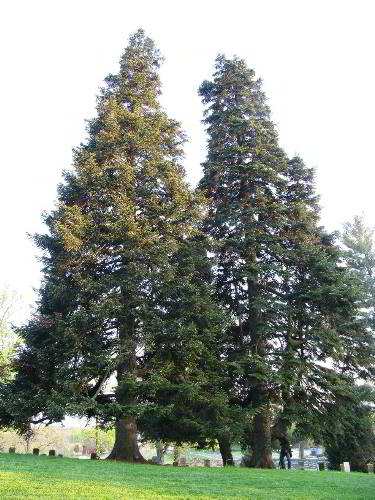
White fir and Balsam Fir
Just inside and to the right of the gate a
nice balsam fir and white fir were growing together. The balsam fir
was the largest I've come across at 8.3ft circumference at 6.9ft
(above
the lower limb which magnifies its CBH) and 9.6ft CBH at the waist
at
2.9ft up. The height was 91.8ft high (tallest known in PA) with a
crown
spread of 38.2ft for a total of 217 AF points if the 9.6ft girth is
used. That makes it one of the largest documented in PA.
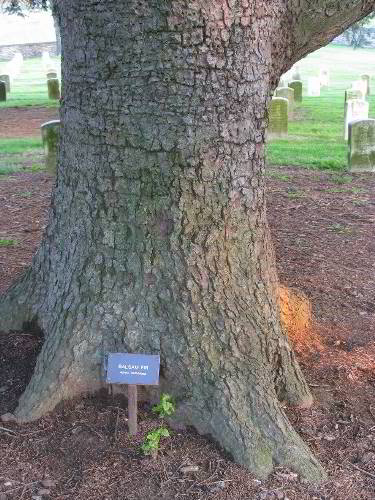
Balsam Fir |
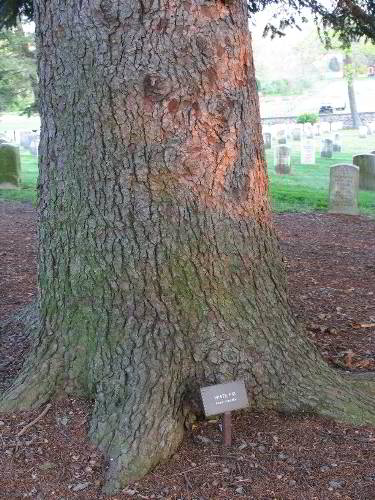
White Fir |
The adjacent white fir was 10ft CBH x 88.2ft high x 45.3ft
crown spread for
220 AF Points. A new species for Scott's PA Champion Tree list,
hence a new
state champion as well.
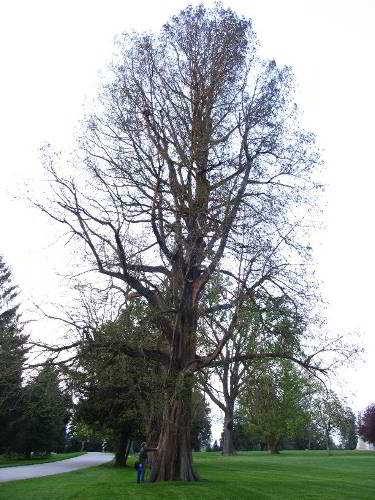
Bald Cypress CBH 15.7 x 97.6 height.
I then turned my attention to the north and just out of site of the
first bald cypress was another. This one was no slouch at 15.7ft CBH
x
97.6ft high x 56.1ft crown spread for 300 AF Points, another new
state
champ!

Tuliptree - 18.8ft CBH x 116.7ft high x 98.1ft crown spread
Just beyond the cypress, the large tuliptree loomed about 150 yards
out.
It was getting towards dusk, so I had to work quickly before I lost
the
light. The highest part of it's top was blown out, but still stood
at a
very respectable 18.8ft CBH x 116.7ft high x 98.1ft crown spread for
367
AF Points. Not a new champ, but definitely the largest tulip I've
had
the pleasure of measuring so far in PA.
The tree tally for 4/30/08 follows:
Species
CBH Height
Comments
Bald
cypress 10
81.6
Bald
cypress 15.7
97.6
new state champ, 300 AF Points, 39 49.107N x 77 13.930W
Balsam
fir
9.6
91.8
new PA height champ
Tuliptree
18.8
116.7 39
49.142N x 77 13.922W
White
fir
10
88.2
new NE height champ, new state champ, 220 AF Points, 39
49.054N x 77 13.921W
Next, I found my way to the Pennsylvania Monument after dark and
started
searching the numerous bronze tablets attached to this mammoth
structure
in hopes of finding relatives. Sure enough, found two relatives on
my
mothers side that fought here, one from the 119th PA Infantry, Co I,
and
the other in the 147th PA Infantry, Co F. I was also greeted by a
friendly ranger who wondered what the heck I was doing out there
well
after dark, scouring the monument with a small pen flashlight.
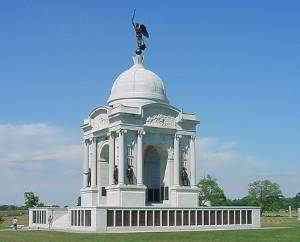
http://www.nps.gov/ner/pgallerycontent/p/l/20061206120211.jpg
The third day, 5/1/08, I decided to take some friends of mine who
also
have the same appreciation for unique forests. One I've mentioned in
earlier posts from time to time, Bill Sweeney, the naturalist
supervisor
at Jacobsburg EE Center, who has intimate knowledge of the trees in
this
park. He mentioned that Mary Byrd Davis had noted old growth in
areas
of the park. It was his intention to show us some of these areas as
well as other noteworthy forests. Bill continues to amaze me with
his
eye for big, tall and old trees. Our first stop was the infamous
Plum
Run. We got out of the vehicle and headed west along the northern
edge
of the stream on a path that heads up the hill back towards the area
where I earlier measured the nice Virginia pines. Along the run and
heading up the hill we noted a number of recently felled trees. A
white
oak went to ~112 rings, another white oak went to ~225 rings at
0.8ft up
at 3.3ft diameter. An old chestnut oak on the hilltop went to ~182
rings 0.7ft up at 2.8ft diameter. Other species in the area were
likely
old as well, but were not yet felled. Visual age estimates would
easily
put 8 species over 150 years old in the Plum Run and Big Round Top
areas:
Species
Visual Age Estimate
Site
White
oak
~225
Plum
Run
Chestnut
oak
~200
Plum
Run
N.
red oak
~200
Big Round Top
Tuliptree
~200
Big Round Top
Black
gum
~200
Big Round Top
White
ash
~200
Big Round Top
Black
oak
~175
Plum
Run
E.
white pine
~150
Big Round Top
Pignut
hickory
~150
Plum
Run
It wasn't long before Bill led us into some incredible hickory trees
going up the path from Plum Run to the hilltop. About halfway up,
hickories started creeping up in the "respectable" height
level.
Further up, a few were downright impressive. The problem, is that
I'm
not sure of their ID. My initial reaction was that they were pignut
hickories, but after talking with a few other ENTS on the subject,
now
I'm not so sure. There were no leaves on the trees since it was
early
May, and the area was devoid of good nut samples. All I had to go on
was bark, and I just saw more pignut hickory character on them than
anything. The jury is still out, some say they're bitternut, others
suggest they may be red hickory, but until I can attain a nut
sample,
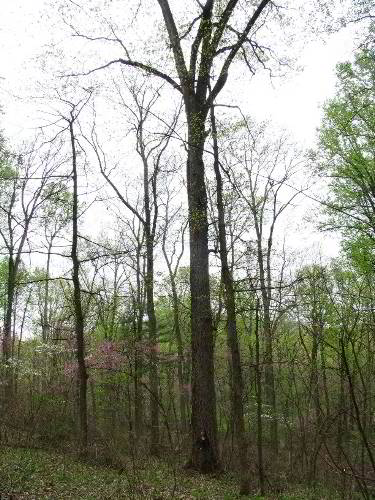
pignut hickory 10.2x136.8aa.jpg |
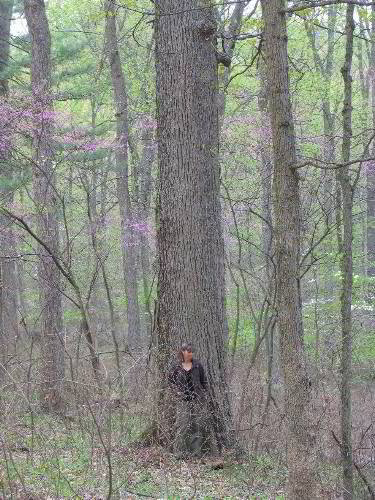
pignut hickory 10.2x136.8aa.jpg |
| |
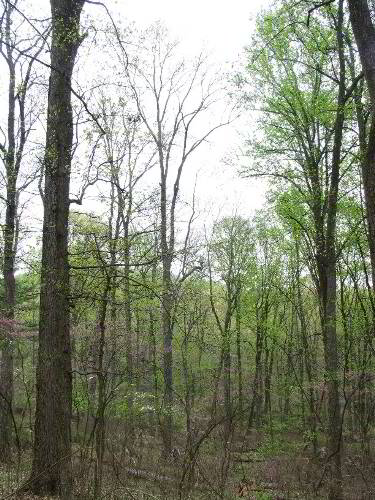
Pignut hickory 7.5x137.9 |
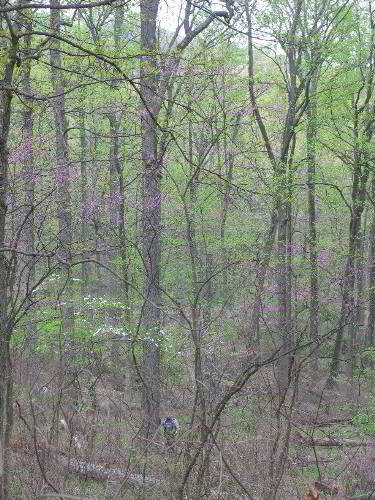
Pignut hickory 7.5x137.9 |
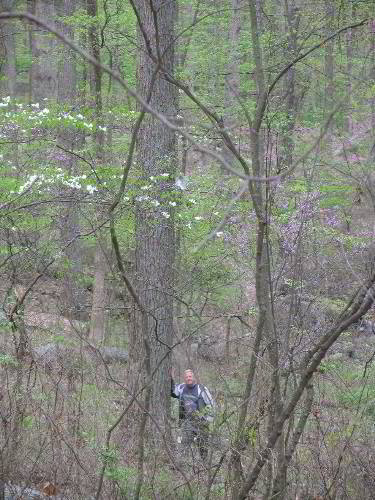
Pignut hickory 7.5x137.9 |
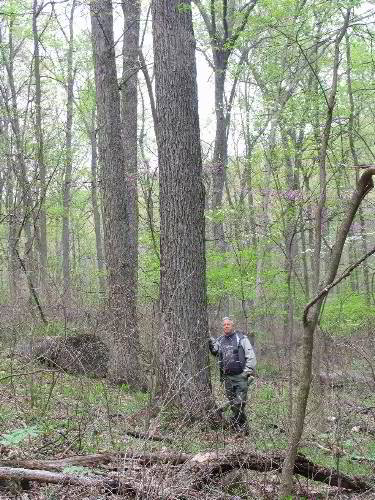
Pignut hickory 7.5x137.9 |
I won't be 100% sure. So, the long and short of it is, I'm going
with my
initial call as probably pignut, and won't be surprised if I'm
proved
otherwise once more evidence is gathered. But still, they're heights
were impressive, be it bitternut, pignut or red hickory, at 10.2ft
CBH x
136.8ft high and the other at 7.5ft CBH x 137.9ft high. This will be
a
new NE height record for either of these three species once nuts are
attained. Both trees grow along the path not more than 75 yards from
each other.
http://www.cnr.vt.edu/dendro/dendrology/syllabus/factsheet.cfm?ID=19
http://www.cnr.vt.edu/dendro/dendrology/syllabus/factsheet.cfm?ID=18
http://www.cnr.vt.edu/dendro/dendrology/syllabus2/factsheet.cfm?ID=826
http://www.cas.vanderbilt.edu/bioimages/frame.htm
Bill still had some nice stuff in store for us. He then led us on a
trail that works its way behind Big Round Top. Along the trail we
found
some really odd looking nuts on the ground. Thought on it a little
while, then it hit us. Kentucky coffee tree! Cool, I never measured
these in the woods before, only saw them in yard settings
previously.
Then another nice little surpise, a small patch of pawpaw, another
new
species to add to the list:
http://www.cnr.vt.edu/dendro/dendrology/syllabus/factsheet.cfm?ID=155
The tree tally for 5/1/08 follows:
Species
CBH Height
Comments
Kentucky
coffee tree
4.8
96.1+ 39
47.090N x 77 14.366W
N.
red oak
N/A
96.1+
Pawpaw
1.1
34+
39 47.191N x 77 14.287W
Pignut
hickory
N/A
93.1+
Pignut
hickory?
10.2
136.8 39
46.989N x 77 14.726W, tac 795
Pignut
hickory?
7.5
137.9 39
46.989N x 77 14.726W, possible new NE height record, tac
794
Tuliptree
N/A
135.1
White
ash
13.2
114.1+
White
oak
N/A
111.1+
The Rucker Index
for
Gettysburg
National
Military
Park
follows:
Species
CBH Height
Comments
RI
Pignut
hickory?
7.5
137.9
tallest documented NE once ID confirmed
108.12
Tuliptree
9.2
130.9
White
ash
13.2
114.1+ 12x100
White
oak
N/A
111.1+
E.
white pine
8.3
110.8
Chestnut
oak
6.9
97.7
Kentucky
coffeetree
4.8
96.1+
N.
red oak
N/A
96.1+
Virginia
pine
5.8
94.5
tallest documented Northeast, 172 AF Points, new PA state
champ
Black
oak
7.3
92
Shagbark
hickory
N/A
92
With more searching, I'm sure we should get all ten species over
100ft.
The RI for Gettysburg is just for starters. I barely scratched the
surface in terms of its tall tree potential.
I highly encourage all Ents to visit this site if you find yourself
to
be in the area. If not for the exceptional history of the area, then
definitely for the hidden big & tall tree records. Besides,
we'll need
someone to try and collect nut samples if they're in the vicinity of
Plum Run. I don't have a clue when my next opportunity to visit that
site will be, but the GPS coordinates given above should put you
easily
within 50ft of their specific trees.
Dale
== 2 of 8 ==
Date: Thurs, Oct 16 2008 5:12 am
From: dbhguru@comcast.net
Dale,
Wow! I stand in awe of your Gettsburg report and also am envious of
those two hickories, pignut or whatever.
Bob
== 4 of 8 ==
Date: Thurs, Oct 16 2008 12:51 pm
From: "Edward Frank"
Dale,
An excellent repot on the park. When I get it posted to the website
I will forward the link to Gary Adelman and Tim Smith (I mentioned
them in regard to the battlefield tours before. I don't know what
else to say about the report but fantastic.
Ed
== 5 of 8 ==
Date: Thurs, Oct 16 2008 1:13 pm
From: Kirk Johnson
I agree, that was a very interesting report, thank you.
Kirk Johnson
== 6 of 8 ==
Date: Thurs, Oct 16 2008 2:34 pm
From: djluthringer@pennswoods.net
Thanks, guys,
Sorry I couldn't get it out sooner.
Dale
== 7 of 8 ==
Date: Thurs, Oct 16 2008 4:51 pm
From: "Darian Copiz"
Dale, Cool hickories and nice report. To me they don't look like
cordiformis - if they're pignut those are some of the most
impressive I've
seen. I'm occasionally in the area, so I might want to check them
out next
time I'm around there.
It's too bad they didn't core that white oak before they cut it. 211
years
isn't nothing - witness trees like that are often the most powerful
connections to the past.
Darian
== 8 of 8 ==
Date: Thurs, Oct 16 2008 7:59 pm
From: "Dale Luthringer"
Thanks, Darian,
Let me know if you'll need coordinates if you get that far. If you
get
on the hiking path that goes up the north side of Plum Run, you'll
go
right past them. They're just off the path on the north side.
Picture
of the nuts in/out of the husk, with a nut split open would help
immensely in getting a good ID for these guys. Carl Harting & I
found
some ripe bitternuts on an island system in the Allegheny River last
week, but I've yet to see any new pignuts on the ground yet this
year.
Dale
==============================================================================
TOPIC: Celtis
http://groups.google.com/group/entstrees/browse_thread/thread/45f604bdf9cc5b11?hl=en
==============================================================================
== 1 of 1 ==
Date: Tues, Oct 28 2008 7:33 pm
From: "Darian Copiz"
ENTS,
Also over the weekend, I'm embarrassed to say that on Saturday I
visited
Gettysburg. Visiting in itself, of course, is not embarrassing, but
not
finding Dale's hickory is. All I can say in my defense is that from
the
description I thought I would be able to find it. I don't have GPS
so
wasn't able to use that, but checked the trails right around Big
Roundtop,
and also got soaked (pouring rain) in the process. Pignuts were the
most
common hickories in the area with some mockernut. I didn't see any
bitternut. I measured a large white ash (maybe the same that Dale
measured)
at 115.9.' Other notable trees were what I'm pretty sure was red
mulberry
along a trail and Celtis tenuifolia on the top of the hill. Sorry I
didn't
confirm the hickory. Dale, you may want to email me a marked up map
showing
the location and I'll try to keep in my records for next time.
Darian
== 3 of 4 ==
Date: Wed, Oct 29 2008 6:59 pm
From: "Dale Luthringer"
Hi Darian,
Thanks for trying to find the pignuts!
I know the trail you were at behind Big Round Top. There was a fat
ash
on the backside (shut up, Will) of the hill with poison ivy on it.
The
"pignuts" were located on the trail that runs on the north
side of Plum
Run. The whole Big Round Top complex is on the west side of Plum
Run.
I've attached a map with "x" marks the spot in the
attached word file in
case you get another chance to head back there.
Dale
|